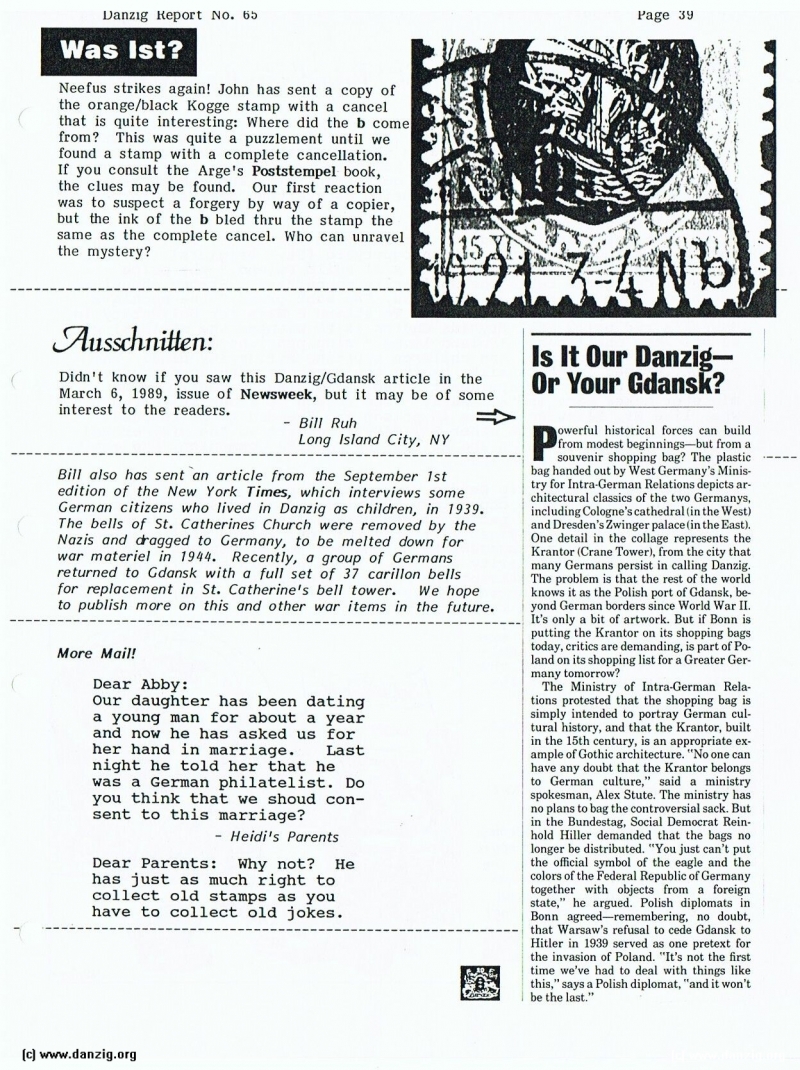
Was Ist?
Neefus strikes again! John has sent a copy of the orange/black Kogge stamp with a cancel that is quite interesting: Where did the b come from? This was quite a puzzlement until we found a stamp with a complete cancellation. If you consult the Arge’s Poststempel book, the clues may be found. Our first reaction was to suspect a forgery by way of a copier, but the ink of the b bled thru the stamp the same as the complete cancel. Who can unravel the mystery?
Ausschnitten:
Didn’t know if you saw this Danzig/Gdansk article in the March 6, 1989, issue of Newsweek, but it may be of some interest to the readers.
- Bill Ruh
Long Island City, NY
Bill also has sent an article from the September 1st edition of the New York Times, which interviews some German citizens who lived in Danzig as children, in 1939. The bells of St. Catherines Church were removed by the Nazis and &agged to Germany, to be melted down for war materiel in 1944. Recently, a group of Germans returned to Gdansk with a full set of 37 carillon bells for replacement in St. Catherine’s bell tower. We hope to publish more on this and other war items in the future.
More Mail!
Dear Abby:
Our daughter has been dating a young man for about a year and now he has asked us for her hand in marriage. Last night he told her that he was a German philatelist. Do you think that we shoud cons ent to this marriage?
- Heidi’s Parents
Dear Parents: Why not? He has just as much right to collect old stamps as you have to collect old jokes.
Is It Our Danzig— Or Your Gdansk?
Powerful historical forces can build from modest beginnings—but from a souvenir shopping bag? The plastic bag handed out by West Germany’s Minist ry for Intra-German Relations depicts arc hitectural classics of the two Germanys, including Cologne’s cathedral Un the West) and Dresden’s Zwinger palace (in the East). One detail in the collage represents the Krantor (Crane Tower), from the city that many Germans persist in calling Danzig. The problem is that the rest of the world knows it as the Polish port of Gdansk, bey ond German borders since World War II. It’s only a bit of artwork. But if Bonn is putting the Krantor on its shopping bags today, critics are demanding, is part of Pol and on its shopping list for a Greater Germ any tomorrow?
The Ministry of Intra-German Relat ions protested that the shopping bag is simply intended to portray German cult ural history, and that the Krantor, built in the 15th century, is an appropriate exa mple of Gothic architecture. “No one can have any doubt that the Krantor belongs to German culture,” said a ministry spokesman, Alex Stute. The ministry has no plans to bag the controversial sack. But in the Bundestag, Social Democrat Reinh old Hiller demanded that the bags no longer be distributed. “You just can’t put the official symbol of the eagle and the colors of the Federal Republic of Germany together with objects from a foreign state,” he argued. Polish diplomats in Bonn agreed remembering, no doubt. that Warsaw’s refusal to cede Gdansk to Hitler in 1939 served as one pretext for the invasion of Poland. “It’s not the first time we’ve had to deal with things like this,” says a Polish diplomat, “and it won’t be the last.”
Danzig Report Vol. 1 - Nr. 65 - October - November - December - 1989, Page 39.
Hits: 3142
Added: 28/06/2015
Copyright: 2025 Danzig.org

